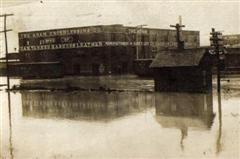|
| |||||
Cuyahoga River
From Brooklyn Centre Wiki
(→Flooding) |
(→Flooding) |
||
| Line 18: | Line 18: | ||
Source: ''"The World's" history of Cleveland : commemorating the city's centennial anniversary''. Cleveland, Ohio: Cleveland World, 1896, 445 pgs. | Source: ''"The World's" history of Cleveland : commemorating the city's centennial anniversary''. Cleveland, Ohio: Cleveland World, 1896, 445 pgs. | ||
| - | '''September 1895 - "A tidal wave visited the harbor Thursday morning. The water suddenly began to fall and before the movement stopped it had gone down 30 inches, leaving some of the skiffs and sail boats in the inner harbor ig and dry. Luckily no large vessel was at that time moving in or out of the river. In twenty minutes the water came back in one big wave, which spent itself on the breakwater and the beach. A peculiar black cloud hung over the lake to the northeast at the time." | + | '''September 1895''' - "A tidal wave visited the harbor Thursday morning. The water suddenly began to fall and before the movement stopped it had gone down 30 inches, leaving some of the skiffs and sail boats in the inner harbor ig and dry. Luckily no large vessel was at that time moving in or out of the river. In twenty minutes the water came back in one big wave, which spent itself on the breakwater and the beach. A peculiar black cloud hung over the lake to the northeast at the time." |
Source: ''Brooklyn Daily Eagle'', NY. Sep 21, 1895 | Source: ''Brooklyn Daily Eagle'', NY. Sep 21, 1895 | ||
Revision as of 20:57, 12 July 2006
A winding river separating the east and west sides of Cleveland. The word "Cuyahoga" is a native American term for "crooked river". It was probably a temporary stumbling block for early settlers making their was west from Connecticut with oxen drawn wagons. Many swamps and thickets added to their woes with the threat of malaria.
The industrial complex has been in place for so long in the valley that it is difficult to imagine it in a more pristine state. Was it heavily wooded, or open grasslands? How deep was the river in the early 1800's? Because of the deep dredging of the river to allow large ships to enter the various ports, it's possible the water level was much different before these major alterations. In fact, it was written in the 1902 book, "Reminiscences" by O.J. Hodge, that there were originally three outlets to Lake Erie and that in dry seasons it was possible to cross the river on foot. So perhaps the pioneers might not have had as much difficulty crossing as it would seem.
About 1831, a whiskey distillery was built on what is now aptly called "Whiskey Island".
An 1896 book, Centennial history of Cleveland, bemoans the fact that the "blue, crystal waters" were a thing of the past. Pollution had apparently already taken it's toll. It's hard to see the Cuyahoga ever having blue clear water because of the mud riverbase.
Flora and Fauna
Prior to the industrialization of the Cuyahoga Valley, the area abounded with otter, muskrats, wolves, panthers, and bears. Many areas along the river were nothing more than swamps filled with bullrushes and mosquitos.
Flooding
June 23, 1882 - Not exactly a flood in the usual sense of the word, but rather the results of a devastating "tidal wave" that reached 12-15' in height that occurred at about 6:30 a.m. Tidal waves of this nature are called a "seiche" and are caused by atmospheric conditions. Source: All about Cleveland : a city cyclopedia, the Cleveland cicerone. Cleveland, Ohio: Whitworth Bros. Co., 1908, 225 pgs (see page 43)
Early February 1883 - A great flood caused by a steady rain that melted the ice and snow. The flooding extended about three miles in distance from the mouth of the Cuyahoga. Scranton Road was covered by about 3 to 4 feet of water. When the flood waters reached leaking oil at the Standard Oil Works, it carried the oil downstream right into the flames of a boiler room of the Great Western Works. The resulting floating fire and explosions created quite a destructive spectacle. This incident predates the more modern and infamous "Burning River" event that made Cleveland a laughing stock. Source: "The World's" history of Cleveland : commemorating the city's centennial anniversary. Cleveland, Ohio: Cleveland World, 1896, 445 pgs.
September 1895 - "A tidal wave visited the harbor Thursday morning. The water suddenly began to fall and before the movement stopped it had gone down 30 inches, leaving some of the skiffs and sail boats in the inner harbor ig and dry. Luckily no large vessel was at that time moving in or out of the river. In twenty minutes the water came back in one big wave, which spent itself on the breakwater and the beach. A peculiar black cloud hung over the lake to the northeast at the time." Source: Brooklyn Daily Eagle, NY. Sep 21, 1895
|
1913 or 1914 - A severe flood swept through the valley as heavy rains caused the river to rise quickly. |
J.L. & H. Stadler Fertilizer Co. Both of these companies were located on Belt Line Road off of Jennings Avenue near Denison Avenue. </td> </tr> |


